Cel shading
Cel shading or toon shading is a type of non-photorealistic rendering designed to make 3-D computer graphics appear to be flat by using less shading color instead of a shade gradient or tints and shades. A cel shader is often used to mimic the style of a comic book or cartoon and/or give the render a characteristic paper-like texture.[1] There are similar techniques that can make an image look like a sketch, an oil painting or an ink painting. It appeared around the beginning of the twenty-first century. The name comes from cels (short for celluloid), clear sheets of acetate which were painted on for use in traditional 2D animation.[2]
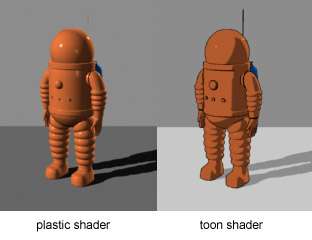
Basic process
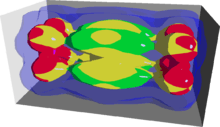
The cel-shading process starts with a typical 3D model. Where cel-shading differs from conventional rendering is in its non-photorealistic illumination model. Conventional smooth lighting values are calculated for each pixel and then quantized to a small number of discrete shades to create the characteristic "flat look", where the shadows and highlights appear as blocks of color rather than being smoothly mixed in a gradient.
Outlines
Wireframe method
Black "ink" outlines and contour lines can be created using a variety of methods. One popular method is to first render a black outline, slightly larger than the object itself. Back-face culling is inverted and the back-facing triangles are drawn in black. To dilate the silhouette, these back-faces may be drawn in wireframe multiple times with slight changes in translation. Alternatively, back-faces may be rendered solid-filled, with their vertices translated along their vertex normals in a vertex shader. After drawing the outline, back-face culling is set back to normal to draw the shading and optional textures of the object. Finally, the image is composited via Z-buffering, as the back-faces always lie deeper in the scene than the front-faces. The result is that the object is drawn with a black outline and interior contour lines. The term "cel-shading" is popularly used to refer to the application of this "ink" outlining process in animation and games, although originally the term referred to the flat shading technique regardless of whether the outline was applied.[3]
The Utah teapot rendered using cel shading:

- The back faces are drawn with thick lines
- The object faces are drawn using a single color
- Shading is applied
Steps 2 and 3 can be combined using multitexturing (part of texture mapping).
Edge-detection method
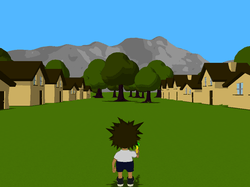
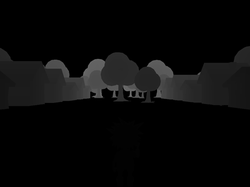


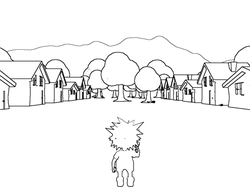

In video games
Starting in the 2000s, cel shading became synonymous in interactive media with the style of the Dreamcast game Jet Set Radio, but it has been applied in numerous other games over the years, including more recent titles such as Cel Damage, The House of the Dead III, No More Heroes and Grand Theft Auto: Chinatown Wars. Other notable examples include The Legend of Zelda: The Wind Waker, Viewtiful Joe, Ni No Kuni, Escape Dead Island, The Legend of Zelda: Breath of the Wild, The Wolf Among Us, Ōkami, Ultimate Spider Man, and Punch-Out!!.
Lists of cel-shaded media
Video games
Some prominent games featuring cel shading include
- Auto Modellista (Sony PlayStation 2)
- Jet Set Radio (Sega Dreamcast)
- Ultimate Spider-Man (PlayStation 2)
- Sly Cooper and the Thievius Raccoonus (PlayStation 2)
- The Legend of Zelda: The Wind Waker (Nintendo GameCube and Wii U)
- The Legend of Zelda: Breath of the Wild (Wii U and Nintendo Switch)
- Harvest Moon: Magical Melody (Nintendo GameCube and Wii)
- XIII (PlayStation 2 and Windows)
- the Katamari series
- Cutscenes in Mirror's Edge use a mixture of drawn characters and 3D toon shaded models, with the latter used mostly in vehicles and such.
Commercials
- 2008 Scion xD Little Deviants
- 2009 Dodge Journey
- Boogie
- BP Connect 2007 ads
- AREVA
- Nick Jr. ID's by Steve Speer
- Commit mint lozenges
- HSBC HSBCdirect.com
- Hewlett Packard xw8400 Workstation Titans of iron
- Mr. Clean
- Pampers Kandoo Flushable Toilet Wipes, Foaming Handsoap
- Post Cereals Fruity Pebbles cereal (Bowling for Fruity Pebbles ad)
- Lego Exo-Force
- L'Oréal Couleur Expert
- Lunchables Pizza (Atlantis Paradise Island promotion ad)
- McCain's Zwak Punch
- Neopets virtual prize code (Canadian Betty Crocker fruit-flavored snacks promotional ad)
- Oscar Mayer Lunchables Chicken Dunks (airhead mysteries ad)
- Sola/Nero/Vena/Olera/Zonte sparkling wine
- Toyo Tires Versado LX all-season touring tires (OK Tire promotional ad)
Television
- Alphablocks
- Boo!
- Bunny Maloney
- Elena of Avalor
- Freedom Project, 2006 Japanese anime series
- Handy Manny
- Knights of Sidonia, 2014 Japanese anime series
- Spider-Man: The New Animated Series
- Iron Man: Armored Adventures
- Archer, adult oriented cartoon usually played on FX.
- Red vs. Blue season 14, an animation/video game based TV series. Based on the video game Halo.
- Transformers: Robots in Disguise, a 2015 animated series and sequel to Transformers: Prime.
- Sofia the First
- Star Wars Resistance
- Steven Universe
- Télétoon Advance
- Les Vacances de Piwi
- Transformers: Cyberverse, a 2018 animated series
- The Simpsons
- Rick and Morty
- RWBY
- Z-Squad
Film
- Appleseed, a 2004 Japanese animated film.
- Mutafukaz: Operation Blackhead, a 2002 crime short film that became the basis for the comic book for the same name produced by Run.
References
- "Stylized Rendering Post Processing". docs.unrealengine.com. Retrieved 2019-09-13.
- Hachigian, Jennifer. "Celshader.com FAQ". Retrieved August 2, 2005.
- Luque, Raul (December 2012). The Cel Shading Technique (PDF). Retrieved December 2, 2014.
External links
- IGN: Jet Set Radio review. Retrieved August 4, 2005.
- GameDev.net – Cel-Shading. Retrieved August 5, 2005.
(Wayback Machine copy)
- sunandblackcat.com – Cel-Shading. Retrieved August 7, 2014.
- tv tropes about cel-shading. Retrieved December 2, 2014